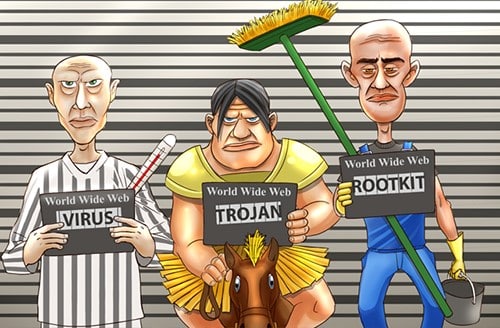In a previous blog, we described the major cyber threats which are prevalent today. To review, they include the following:
- Malware
- Spyware
- Adware
There is no doubt that each of these are bad in their own way, but typically Spyware and Malware are the worst. The underlying malicious code behind these threats is known as a “Trojan Horse,” which is the focal point of this blog post.
Essentially, the Trojan Horse is a line of malicious software code that contains a .exe file. This is the file that is normally used to install and launch just about any kind of software application. Today, an end user can actually be tricked into downloading a Trojan Horse. Let us illustrate this with an example.
Suppose you are surfing the Internet, trying to find a good restaurant to eat at. All of a sudden, a message appears in your Web Browser which states that your computer has been infected by a covert virus, and that you need to click on a link in order to download a necessary patch. Being taken completely off guard by this, all of a sudden you click on the link and assume that all will be well.
But actually, not all is well. What you have downloaded is a Trojan Horse software. While you may not be aware of it, it is actually running in the background on your computer. It is collecting all kinds of information about you, such as your Web browsing history, your friends and contacts on your Social Media sites, etc. But most importantly, it is collecting your most private information, which includes your username/password combination, credit card information, banking details, etc.
Many people have the notion that a Trojan Horse will lock your files or even your hard drive. While it can do this, most Trojan Horse malwares just sit behind the scenes on your computer for a very a long time, and transmit what it is collecting to the Cyber attacker.
This of course, can then be used to launch an Identity Theft attack against you when you least expect it, possibly many months or years down the road.
It is important to note that most Trojan Horse attacks occur via the use of Social Engineering. In our example, the Cyber attacker preyed upon the fears of the end user by making him or her think that their computer was at risk. This kind of malware is very often disguised as legitimate software, and can be deployed by just about any means possible.
Interestingly enough, Trojan Horses do not replicate themselves, unlike other forms of Adware and Malware. Rather, it is a focused attack which is meant to spy on just you. This doesn’t mean to say that a Cyber attacker has followed you and knows your whereabouts, but rather, by the act of randomness, you were picked.
This doesn’t mean that you should not be careful about what you connect to on a public wireless domain, or about using your credit card when making a transaction online or offline.
Look forward to a future blog post that will examine the technical details of a Trojan Horse and what you can do to avoid becoming a victim.






